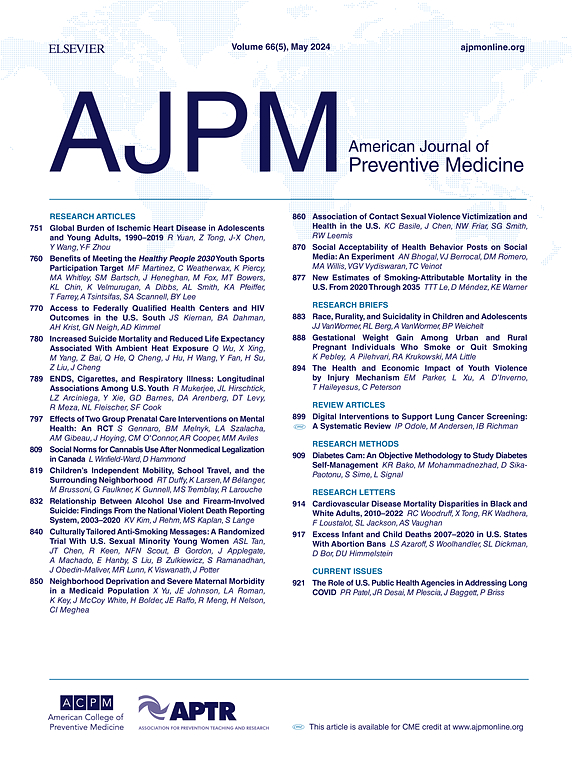在美国高中生中,酒精使用在性约会暴力受害者和企图自杀之间起中介作用。
IF 4.3
2区 医学
Q1 MEDICINE, GENERAL & INTERNAL
引用次数: 0
摘要
导读:遭受性约会暴力(SDV)的高中生可能将酒精作为创伤、情感痛苦和受害压力的应对机制,由于判断力受损而增加了自杀企图的风险。很少有研究调查饮酒如何影响SDV与自杀未遂可能性之间的关系。我们评估了酒精使用在这一关联中的中介作用。方法:我们分析了来自2021年汇总的青少年风险行为监测数据集的加权10875名美国高中生的横截面数据。我们进行了多变量逻辑回归分析,以评估SDV与自杀未遂可能性之间的关系。我们还进行了四向分解中介分析。数据是在2024年分析的。结果:在所有高中生样本中,SDV与自杀企图显著相关(AOR=4.85)。结论:SDV与高中生总体和跨亚组的自杀企图相关。酒精使用起着关键的中介作用,这表明需要有针对性的酒精特定干预措施来降低自杀风险,特别是在男性学生、年轻群体和种族/少数民族等高风险群体中。在这些弱势群体中优先采取酒精干预措施,可能会解决自杀企图方面的健康差异,并加强自杀预防工作。本文章由计算机程序翻译,如有差异,请以英文原文为准。
Alcohol Use Mediates the Association Between Sexual Dating Violence Victimization and Attempted Suicide Among U.S. High School Students
Introduction
High school students experiencing sexual dating violence may use alcohol as a coping mechanism for trauma, emotional pain, and stress from victimization, increasing the risk of suicide attempts due to impaired judgment. Few studies have investigated how alcohol consumption influences the association between sexual dating violence and the likelihood of attempted suicide. We assessed the mediating role of alcohol use in this association.
Methods
We analyzed cross-sectional data of weighted 10,875 U.S. high school students from the 2021 pooled Youth Risk Behavior Surveillance dataset. We performed multivariable logistic regression analyses to assess associations between sexual dating violence and the likelihood of attempted suicide. We also conducted the four-way decomposition mediation analyses. Data were analyzed in 2024.
Results
Sexual dating violence was significantly associated with attempted suicide in the overall high school student sample (AOR=4.85, p<0.001), with stronger effects observed in subgroups, including males, 11th and 12th graders, and Black or African Americans. Alcohol use attributed 29.29% of the total effect of sexual dating violence victimization on attempted suicide, with 4.11% attributed to alcohol use only, and 25.18% to both interactions (between sexual dating violence victimization and alcohol use) and mediation (alcohol use).
Conclusions
Sexual dating violence is associated with suicide attempts among high school students overall and across subgroups. Alcohol use plays a critical mediating role, indicating the need for targeted alcohol-specific interventions to reduce suicide risk, particularly among high-risk groups such as male students, younger cohorts, and racial/ethnic minorities. Prioritizing alcohol interventions among these vulnerable populations may address health disparities in suicide attempts and enhance suicide prevention efforts.
求助全文
通过发布文献求助,成功后即可免费获取论文全文。
去求助
来源期刊

American Journal of Preventive Medicine
医学-公共卫生、环境卫生与职业卫生
CiteScore
8.60
自引率
1.80%
发文量
395
审稿时长
32 days
期刊介绍:
The American Journal of Preventive Medicine is the official journal of the American College of Preventive Medicine and the Association for Prevention Teaching and Research. It publishes articles in the areas of prevention research, teaching, practice and policy. Original research is published on interventions aimed at the prevention of chronic and acute disease and the promotion of individual and community health.
Of particular emphasis are papers that address the primary and secondary prevention of important clinical, behavioral and public health issues such as injury and violence, infectious disease, women''s health, smoking, sedentary behaviors and physical activity, nutrition, diabetes, obesity, and substance use disorders. Papers also address educational initiatives aimed at improving the ability of health professionals to provide effective clinical prevention and public health services. Papers on health services research pertinent to prevention and public health are also published. The journal also publishes official policy statements from the two co-sponsoring organizations, review articles, media reviews, and editorials. Finally, the journal periodically publishes supplements and special theme issues devoted to areas of current interest to the prevention community.
 求助内容:
求助内容: 应助结果提醒方式:
应助结果提醒方式:


